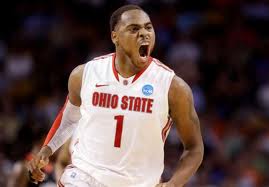![]() (This is a guest post by Chris Williams, one of many applicants for the recently open positions on the MotSaG staff.)
(This is a guest post by Chris Williams, one of many applicants for the recently open positions on the MotSaG staff.)
With just a little less than 60 days until the first game of the college football season, the itch to write was too strong not to scratch. I don’t normally encourage preseason rankings, whether it is polls or Heisman predictions, but I was asked to list my top five Heisman candidates for the upcoming season. I have not listed them in any particular order (it’s the preseason, there’s no need to get too crazy) and these are the top five players who I think have a great chance to make a run at the trophy formerly known as the Downtown Athletic Club trophy.
Several others were considered: AJ McCarron will likely break the Alabama record for passing yards this season, but I fear TJ Yeldon will take votes away from him. I also think that the focus will be on his pursuit of a fourth ring rather than this season’s accomplishments and this is not a career award. Lache Seastrunk will have a great year at Baylor, but voters tend to shy away from players whose team doesn’t have a fantastic record so he may be in trouble. Marcus Mariota will turn some heads again this year, but we’ll see if there’s any post-Kelly drop off. Finally, I’m a huge JaDaveon Clowney fan, but I don’t think we’ll see a purely defensive player win this trophy any time soon.
1. Marqise Lee, WR, USC: Lee was the best player in the country last season, in my view, and was stuck on an unbelievably underachieving team. He was in the top three in the country in receptions, receiving yards, receiving touchdowns, receptions per game, and yards per game. Additionally, he was in the top ten in the nation in average punt return yardage. He did all that while playing opposite Robert Woods, who was drafted 41st overall in April’s NFL draft and in a season which saw Matt Barkley fall from being potentially the top pick in the 2012 NFL Draft (had he left) to being a fourth-round pick in 2013.
A wide receiver hasn’t won the Heisman since current College GameDay cast member (and former member of TTUN), Desmond Howard, won it in 1991. Football, on every level, has become a pass-centric game over the years and because of that, only twice since 2000 a non-quarterback has taken home the 25-pound trophy (both were running backs). I think it’s time that a receiver gets some of the credit for the success of the passing game because someone is beating defenders and then catching the balls that these quarterbacks are throwing. The only thing that may hold Lee back this year is the uncertainty at quarterback for the Trojans this season, but then again it’s not as if Barkley was solid last year.
2. Teddy Bridgewater, QB, Louisville: Bridgewater is the trendy pick right now due to a combination of the Cardinals’ destruction of the Gators in the Sugar Bowl and the easy schedule that lies ahead in 2013. Bridgewater easily had the best game that any quarterback had against the Gators defense all last season. He threw for more yards (266) and was the only quarterback who threw for more touchdowns (2) than interceptions (1) against them.
Louisville’s schedule this season isn’t exactly daunting either. That might have been helped had Virginia Tech’s Logan Thomas opted for the NFL as it is rumored that had he done so, Frank Beamer was going to try to get out of the Alabama game in Week 1 and Charlie Strong was going to try to jump into it. However, that didn’t happen and Louisville has a schedule that only has games in which the Cardinals should be the favorite. Only Kentucky and Cincinnati, both with new head coaches, have any hope of ruining an undefeated season. However, with this schedule, Bridgewater would need another great bowl performance to get the public’s attention — too bad Heisman voting is before bowl season.
3. Johnny “Football†Manziel, QB, Texas A&M: Only former Buckeyes running back Archie Griffin has won the Heisman twice, winning it his junior and senior seasons, in 1974 and 1975. Manziel was the first freshman (redshirt or otherwise) to take the trophy home last season after becoming one of five players in college football history to throw for 3000 yards and rush for 1000 yards (and he’s the only one of the five that didn’t need a conference championship or bowl game to reach either milestone.) The bright side is that Manziel should have a much stronger understanding of Kevin Sumlin’s system in his second season (and first full offseason as the starter). Offensive Coordinator Kliff Kingsbury leaving to be head coach at Texas Tech will hurt some, but Jake Spavital (a Dana Holgerson prodigy) should fill in just fine. The loss of All-American (and second overall pick in April’s NFL Draft) left tackle Luke Joeckel is certainly a concern, but the return of senior (and fellow All-American) Jake Matthews lessens that to some degree as he will move from right to left tackle. Manziel is eligible for the NFL after this season and that may inspire him to put up video game numbers again, but it will be much harder with a target on that number 2 this time.
4. Tajh Boyd, QB, Clemson: Tajh Boyd was commit to the Buckeyes in 2009, but chose the Tigers late in the process, presumably because he didn’t want to wait out the Terrelle Pryor era (… and what an era that was). It looks like he made a choice that works for him as he seems to fit well in Chad Morris’ (offensive coordinator). Boyd threw for nearly 4000 yards (3896) last season and didn’t have his best receiver, Sammy Watkins, at full strength for most of the season. Boyd ended his redshirt junior season with a great performance against LSU in the Chick-Fil-A Bowl. He threw for 346 yards against the Tigers defense (only Tyler Wilson threw for more against them) and orchestrated an impressive game-winning drive, which included converting a 4th and 16 with just over a minute remaining. Watkins is reportedly healthy this season and if he stays that way, expect big numbers for him and Boyd both because they have a great connection.
Boyd has a great chance to fuel the fire for his candidacy in Week 1 this season as the Tigers host SEC East Champions Georgia on August 31st. The Tigers host Florida State in Week 8 and Boyd will be matched up against freshman sensation Jameis Winston (keep an eye on this kid) and then finish their regular season with a visit to Steve Spurrier and the Gamecocks. Boyd will have several chances to get Heisman-worthy attention; all he has to do is step it up just as he did against LSU.
5. Braxton Miller, QB, Ohio State: Historically, quarterbacks in their second year under Urban Meyer thrive as they have a better understanding of his offensive philosophy and the required reads (i.e. Alex Smith, Chris Leak, Tim Tebow). Last year’s undefeated run and Meyer’s past success will give Miller some early Heisman hype. The Buckeyes’ success was far too dependent on Miller’s legs last season, specifically because when he didn’t know what to do, or the play broke down, his answer was to run. If I had compiled this list just a few weeks ago, I definitely would not have included Miller due to the Buckeyes’ lack of a punter. Field position would then, potentially, have seriously hurt his chances of success with punting duties being the responsibility of a placekicker (Drew Basil) and/or a wide receiver (Frank Epitropolous) after they were unable to offer a scholarship to Johnny Townsend due to scholarship reductions (he ended up going to Florida). However, with the signing of Australian Cameron Johnston, that concern has calmed significantly. Miller threw considerably better this spring and he looked a lot more comfortable doing so and I expect a breakout season for sophomore wide receiver Michael Thomas who is a big target that Miller should be able to rely upon to convert first downs.
Miller, by far, isn’t the favorite to win the Heisman, but there’s absolutely no reason he shouldn’t have a season worthy of a trip to New York as a finalist.
 Deshaun, who left Ohio State as a junior, was a part of two memorable Ohio State teams that made deep runs in the NCAA tournament, getting to the Final Four as a sophomore in 2012. The Buckeye’s run to the Final Four was due in part to a stellar stretch of tournament play by Deshaun himself.
Deshaun, who left Ohio State as a junior, was a part of two memorable Ohio State teams that made deep runs in the NCAA tournament, getting to the Final Four as a sophomore in 2012. The Buckeye’s run to the Final Four was due in part to a stellar stretch of tournament play by Deshaun himself.